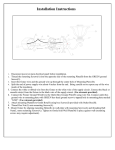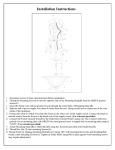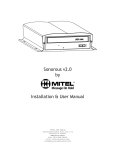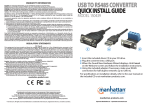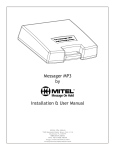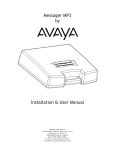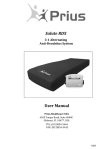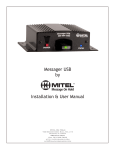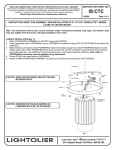Download TroposAir 1133+1135 Instructions / Assembly
Transcript
READ AND SAVE THESE INSTRUCTIONS Hercules - 96SGD It is highly recommended that a professional install this fan. Thank you for purchasing a Gulf Coast Fans Inc. product. It will provide years of cost efficient comfort. With over a decade of experience in ensuring quality workmanship at an affordable price, we stand behind our product and we hope you will too. IMPORTANT PRECAUTIONS 1 Read these instructions carefully before you start. 2 Turn off the power at the source before installation, servicing, or cleaning. 3 WARNING--TO REDUCE THE RISK OF FIRE OR ELECTRIC SHOCK, DO NOT USE THIS FAN WITH ANY SOLID STATE SPEED CONTROL DEVICE. USE ONLY GULF COAST CONTROLS. 4 WARNING--TO REDUCE THE RISK OF PERSONAL INJURY, DO NOT BEND THE BLADE IRONS WHEN INSTALLING ON BLADES, BALANCING THE BLADES, OR CLEANING THE FAN. DO NOT INSERT FOREIGN OBJECTS IN BETWEEN ROTATING FAN BLADES. 5 WARNING--TO REDUCE THE RISK OF FIRE, ELECTRIC SHOCK, OR PERSONAL INJURY, MOUNT FAN TO AN OUTLET BOX MARKED "ACCEPTABLE FOR FAN SUPPORT" AND USE THE MOUNTING SCREWS PROVIDED WITH THE OUTLET BOX. 6 If you don't feel comfortable hanging and wiring this fan, we recommend that you hire a qualified electrician to install it. 7 All wiring and electrical connections must meet the National Electrical Code and any local codes that may apply. 8 This fan must be mounted on a ceiling at least 10 feet high. Gulf Coast Fans 2014 - Portions â 1993 Page 1 To begin with, the site of installation must be clear of any obstructions. Walls, cabinet or cupboard doors, and AC/heating vents (strong air currents will cause fan to wobble ) are common obstructions. Also, you will need a securely mounted outlet box that is listed for fan support. The only tools you will need are: A medium Phillips screwdriver, wire cutter/stripper, common sense, and a little caution. I. Inventory the parts A. Remove all of the parts from the top styrofoam and remove the styrofoam. Use this top piece to support the fan during preliminary assembly. Screw Package 2 Wood Screws 2 #8 Machine Screws 2 Spring Washers 2 Star Washers 2 Flat Washers 1 Wood Screws 1 Spring Washers 1 Flat Washers 21 Blade Screws B. Remove all parts from plastic bags, including the blades, packaged separately, and screw package. 21 Blade Washers 11 Motor Screws 3 Wirenuts CANOPY BOTTOM CUP Remote Control Clevis pin Safety clip HANGING BRACKET w/2 CANOPY SCREWS YOKE COVER II. Preliminary Assembly. BALL & DOWNROD ASSY Washer Transmitter w/9V Battery BLADE ARMS FIG. 1 A. Remove the three (or five) shipping blocks from the face of the motor and discard them. Wall Bracket 2 Bracket Mounting Screws REMOVE SHIPPING BLOCKS (DISCARD) B. Remove the three (3) 1/8"-32x1/4" screws from the switch cup plate on motor assembly. Fig. 2. FIG. 2 SWITCH CUP SCREWS C. Place the motor (with the bottom cup mounting plate down) in the top styrofoam. Loosen the two set screws in the coupler (Fig. 1). If you are replacing the downrod with a longer one, now is the time to do so. FIG. 3 D. Feed the wires through the yoke cover, canopy and downrod. Seat the downrod into the yoke with the holes in each aligned. Insert the clevis pin, and secure with the washer and safety clip (Fig. 2) Tighten the coupler set screws against the downrod. Slide the yoke cover down to cover the yoke. E. At this time you may want to shorten the wires from the fan to 6" from the ball. This helps when you tuck the wires into outlet box. F. Snap the Blade Arm onto the Blade's face that you want to show. Using four (4) screws and washers per blade, attach the blade securely to the Blade Arm. Repeat until all five Blades are assembled onto Blade Arms. (Fig 5) FIG. 4 FIG. 5 Gulf Coast Fans 2014 - Portions â 1993 Page 2 II. Preliminary Assembly continued from page 2. WARNING - To Reduce The Risk Of Fire, Electric Shock, Or Personal Injury Mount Fan To An Outlet Box Marked "Acceptable For Fan Support" And Use The Mounting Screws Provided With The Outlet Box. For the future connection of the safety cable, partially install 1 wood screw, 1 flat washer and 1 spring washer, leaving 1/8" to 1/4" exposed. Position this screw where it will be covered by the canopy, will not interfere with the hanging bracket, and is secured into a wood support member. Inside of outlet box is a common place. See Fig 6. F. Remove one canopy screw and loosen the other. Take the hanging bracket and secure it to the outlet box (marked Acceptable For Fan Support) using the mounting screws provided with the outlet box (Fig 6). Tighten them evenly. If you are mounting the fan directly to the building structure, use the wood screws provided, and secure to a joist. Make sure all of the wires are accessible and are not being pinched. Also, make sure the bracket doesn't wobble. Screw for Safety Cable Hanging Bracket FIG. 6 Expand the loop of the safety cable and place loop over screw head and under flat washer. Tighten loop of safety cable. Tighten wood screw to secure safety cable. See Fig 7. Canopy Screw III. Hanging the Fan FIG. 7 Holding the fan firmly, carefully lift it up to hanging bracket. Place the ball into cradle of the bracket. Turn the entire motor assembly until it locks into place. The tab on the bracket must be in the groove in the ball. Make sure the wires are not being pinched. Also Fig 7. IV. Wire connections This fan includes a remote control, and requires basic mains wiring. Keep in mind, the supply wire colors may vary. (The wire colors in parentheses are commonly found in existing structures.) Use the large orange wirenuts to make the connections. FIG. 8 BLACK (from fan) 1. Black wire from fan to hot supply (black) 2. White wire from fan to neutral supply (white) 3. Green ground wires to outlet box ground (bare) SUPPLY HOT/LIVE WHITE (from fan) SUPPLY NEUTRAL GREEN (from bracket) GROUND/EARTH GREEN (from ball) Now tuck the wires and wirenuts carefully into outlet box. Make sure wirenuts remain tightly on connections. CANOPY V. With the motor in place and the wires out of the way, slide the canopy up to the hanging bracket. The canopy screw in the bracket will come through the large end of the key slot in the canopy. Fig. 9. Turn the canopy slightly, counter-clockwise, to hold in place, and insert remaining canopy screw. Tighten the screws. VI. The next step is to mount the blade assemblies on the motor. Rotate the motor face so that two empty screw holes align with the cut-outs on the bottom cup mounting plate. Insert one motor screw into one of the holes in a blade arm's base. Holding the blade assembly in one hand, place screwdriver tip into screw head to keep screw held in. Lift blade assembly into place, and screw it into the appropriate hole in the motor. Fig 10. Now insert another screw into the other hole and tighten both screws. Repeat this with the rest of the blade assemblies, and retighten all of the screws. VII. The final assembly is attaching the bottom cup and it's easy. If you are adding a light kit, now is the time to attach it to the switch cup. Lift the cup into place, aligning the three screw holes in the cup with those on the mounting plate. Insert one of the screws removed earlier and thread into switch cup plate. Insert the remaining switch cup screws and tighten all. Fig. 11. FIG. 9 Fig. 10 Fig. 11 Gulf Coast Fans 2014 - Portions â 1993 Page 3 DIP Switches 1 There are 16 possible code frequencies, which are set using the 4 DIP switches located in the battery compartment of the transmitter. You will Battery only need to change the DIP switch settings if you install more than Compartment one fan in the area, or if you encounter radio frequency interference from another RF source. 4. Switch on the main power to activate the receiver, indicated by one beep. 5. Within 3 minutes after the power is turned on (one beep), press the transmitter's “ON/OFF” key (Fig 13) and do not release (min. 5 seconds) until receiver issues four beeps which indicates successful code match. 6. After successful code match, the fan automatically returns to the original speed as indicated on LCD screen. 7. Press any transmitter button to check for proper functioning. 8. For code changes, repeat steps 1 to 8. Fig 12 ON 2 3 4 Press & Hold 9V BATTERY VIII. The Remote Control A. To set the operating frequency and code-match the receiver: 1. Remove the battery cover from the back of the transmitter. 2. Install 9V Battery 3. Set the code using the DIP switches of transmitter. Fig 12. Battery Cover Fig 13 B. There are 5 buttons and the function of each button is described below. The receiver will beep for each function triggered by the push of a button on the transmitter. 1 1. SPEED?: This button is to switch the fan speed from high to low. There 2 are 6 speeds in total. Note: When the fan is off, we can start the fan by pushing this button. Choose your speed according to the LCD. 3 2. SPEED : This button is to switch the fan speed from low to high. There are 6 speeds in total. When set to the highest speed, the LCD 4 5 display will show "MAX". Note: When the fan is off, we can start the fan by pushing this button. Choose your speed according to the LCD. Fig 14 3. FAN/OFF : When the fan is "OFF", push this button to start the fan. When the fan is "ON", push this button to turn it off. ? 4. FOR/REV: This is a forward/reverse direction button. Press this button to change from forward to reverse or from reverse to forward. When the fan is running counter-clockwise (looking up at it), the airflow is downward, which is recommended for best efficiency and for summertime. Clockwise rotation gives upward airflow for gentle circulation suitable for winter. 5. LIGHT: This is an on/off button for light. Push this button to turn on and turn off the light. If you are using incandescent bulbs, a dimming cycle can be used by pressing and holding this button. (Dimming function is not suitable for CFL or LED lamps.) C. Memory Function: This control has memory function. When the power is turned off, the control will automatically record the last fan and light mode. Next time when the fan is turned on, the control will automatically set to the previous fan speed and brightness. IX. Troubleshooting Fan Check power supply. won't Check wirenut connections. run Re-set remote frequency code. Fan Allow 24 hrs to fully seat bearings makes Screw(s) is(are) loose somewhere. noise - Ball is not seated properly. Solid-state control in the circuit. Fan Bracket is loose at the ceiling. wobbles Loose screw at top of fan. Ball is not seated properly. We stand behind our product and always strive to satisfy our customer. Gulf Coast Fans, Inc. 300Dunbar Ave Oldsmar Florida 34677 (813)-855-7384 Gulf Coast Fans 2014 - Portions â 1993 Page 4




